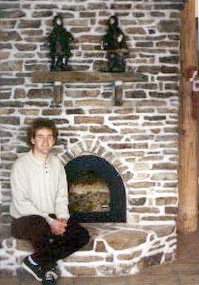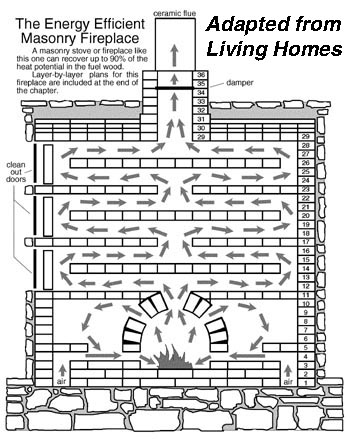Granny's Country Store > Home-Building Resources > Masonry Stoves | Search | View Cart
The Masonry Stove or Russian Fireplace
A Brief Overview
by Thomas J. Elpel, Author of Living Homes

Many animals use simple sticks and rocks and leaves as tools, but only humans have learned to use and control fire. It is the one technology that truly sets our species apart. Mastery of fire enabled our ancestors to stay warm and move into new lands, to make pottery, build shelters, manipulate ecosystems and to join hands around the circle of light, singing songs deep into the night.
Today we have a much greater mastery of fire, and we harness it in many forms, using coal, oil, natural gas, and electricity as substitutes for the wood fires of our ancestors. These substitutes effectively power our industries and run our cities. Yet, for the country home with a source of fuel wood, it is still hard to beat the efficiency and aesthetics of a good old-fashioned wood fire.
The aesthetics of the wood fire are an important point. It is for that reason alone, not energy efficiency, that builders still put cheap fireplaces in so many condominiums and apartments today. And although I envision a world of houses so energy efficient that they need no heating system, I would not willingly give up my own wood stove! I like to stare at the flames and soak up the warmth on those cold winter days, even when the house is already warm.
 The type of fireplace we built is traditionally called a "masonry stove" or "masonry heater". It is also called a "Russian fireplace", but the idea came from eastern Europe more than Russia. The original designs had solid doors like stoves. The type I advocate are made to look like fireplaces yet function as masonry stoves, so they are best described as "masonry fireplaces". I use the terms stove or heater interchangeably, and fireplace to specify stoves with a visible fire.
The type of fireplace we built is traditionally called a "masonry stove" or "masonry heater". It is also called a "Russian fireplace", but the idea came from eastern Europe more than Russia. The original designs had solid doors like stoves. The type I advocate are made to look like fireplaces yet function as masonry stoves, so they are best described as "masonry fireplaces". I use the terms stove or heater interchangeably, and fireplace to specify stoves with a visible fire.
Masonry stoves are designed to burn a hot fire, with the air supply and chimney damper wide open. This results in a clean burn, with little visible smoke. The distinctive feature of the heaters is a series of baffles to pull the heat out of the exhaust. The masonry absorbs the heat of the fire, then radiates it gradually back into the room.
I first learned about masonry stoves while in high-school through an article in The Mother Earth News magazine (October-November, 1994). A house at Mother's Eco-Village in North Carolina included a masonry stove designed by Basilio Lepuschenko of Maine. Our initial house plans included only a wood cookstove in the kitchen, but later we built an addition to the house and we wanted an efficient fireplace for the new family room. I wrote away for Lepuschenko's stove plans and studied them intently, but the designs did not fit our space. The Missouri Masonry Stove Plans (Free PDF) are somewhat similar.
We also ordered The Book of Masonry Stoves for more ideas, and we studied the pre-manufactured kits made from refractory cement. The kits cost $4,000-$5,000 and still required brick or stone facing, plus the chimney. We could not afford much more than $1,000 for the whole job.
 As was often the case, we were forced by necessity to design and build our own fire place from the ground up. We built the entire core of ours out of ordinary fire brick and faced the front with stone. The total cost of the project was about $1,000. We light a fire in the masonry fireplace about once a week through the winter, on average. It takes all day to heat up the mass of rock, but then it radiates heat out for the next three days. By the end of the week the house starts feeling a little cool, but we usually put on long-sleeved shirts and wait for the weekend and company before lighting the fire again.
As was often the case, we were forced by necessity to design and build our own fire place from the ground up. We built the entire core of ours out of ordinary fire brick and faced the front with stone. The total cost of the project was about $1,000. We light a fire in the masonry fireplace about once a week through the winter, on average. It takes all day to heat up the mass of rock, but then it radiates heat out for the next three days. By the end of the week the house starts feeling a little cool, but we usually put on long-sleeved shirts and wait for the weekend and company before lighting the fire again.
The plans included in my book Living Homes are based on the masonry fireplace we built, but with a few improvements for a next-generation design. For complete details on the book, please go to: Living Homes: Stone Masonry, Log, and Strawbale Construction
-Please scroll down the page for the "Add to Order" button.-